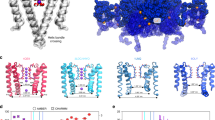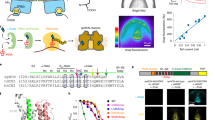Abstract
Ion channels catalyze the selective transfer of ions across the membrane in response to a variety of stimuli. These channels gate by controlling the access of ions to a centrally located water-filled pore. The crystal structure of the Streptomyces lividans potassium channel (KcsA) has allowed a molecular exploration of this mechanism. Electron paramagnetic resonance (EPR) studies have uncovered significant conformational changes at the intracellular end of the second transmembrane helix (TM2) upon gating. We have used site-directed spin labeling (SDSL) and EPR spectroscopy in an attempt to quantify the structural rearrangements of the KcsA TM2 bundle underlying the transition from the closed to the open state. Under conditions favoring the closed and open conformations, 10 intersubunit distances were obtained across TM2 segments from tandem dimer constructs. Analysis of these data points to a mechanism in which each TM2 helix tilts away from the permeation pathway, towards the membrane plane, and rotates about its helical axis, supporting a scissoring-type motion with a pivot point near residues 107–108. These movements are accompanied by a large increase in the diameter of the vestibule below the central water-filled cavity.
This is a preview of subscription content, access via your institution
Access options
Subscribe to this journal
Receive 12 print issues and online access
$189.00 per year
only $15.75 per issue
Buy this article
- Purchase on Springer Link
- Instant access to full article PDF
Prices may be subject to local taxes which are calculated during checkout




Similar content being viewed by others
References
Armstrong, C.M. J. Gen. Physiol. 58, 413–437 (1971).
Liu, Y., Holmgren, M., Jurman, M.E. & Yellen, G. Neuron 19, 175–184 (1997).
Yi, B.A., Lin, Y.F., Jan, Y.N. & Jan, L.Y. Neuron 29, 657–667 (2001).
Sadja, R., Smadja, K., Alagem, N. & Reuveny, E. Neuron 29, 669–680 (2001).
Doyle, D.A. et al. Science 280, 69–77 (1998).
Cuello, L.G., Romero, J.G., Cortes, D.M. & Perozo, E. Biochemistry 37, 3229–3236 (1998).
Perozo, E., Cuello, L. & Cortes, D. Nature Struct. Biol. 5, 459–469 (1998).
Perozo, E., Cortes, D.M. & Cuello, L.G. Science 285, 73–78 (1999).
Hubbell, W.L., Gross, A., Langen, R. & Lietzow, M.A. Curr. Opin. Struct. Biol. 8, 649–656 (1998).
Hubbell, W.L., Cafiso, D.S. & Altenbach, C. Nature Struct. Biol. 7, 735–739 (2000).
Eaton, G.R. & Eaton, S.S. In Biological magnetic resonance, Vol. 8 (eds Berliner, L.J. & Reuben, J.) 340–397 (Plenum, New York; 1989).
Rabenstein, M.D. & Shin, Y.K. Proc. Natl. Acad. Sci. USA 92, 8239–8243 (1995).
Hustedt, E.J., Smirnov, A.I., Laub, C.F., Cobb, C.E. & Beth, A.H. Biophys. J. 72, 1861–1877 (1997).
Steinhoff, H.J. et al. Biophys. J. 73, 3287–3298 (1997).
Chapman, M.L., VanDongen, H.M. & VanDongen, A.M. Biophys. J. 72, 708–719 (1997).
Zheng, J. & Sigworth, F.J. J. Gen. Physiol. 110, 101–117 (1997).
Liu, Y. & Joho, R.H. Pflugers Arch. 435, 654–661 (1998).
Townsend, C. & Horn, R. J. Gen. Physiol. 113, 321–332 (1999).
Lu, T. et al. Nature Neurosci. 4, 239–246 (2001).
Sompornpisut, P., Liu, Y.-S. & Perozo, E. Biophys. J. In the press (2001).
Roux, B., Bernèche, S. & Im, W. Biochemistry 39, 13295–13306 (2000).
Isacoff, E.Y., Jan, Y.N. & Jan, L.Y. Nature 353, 86–90 (1991).
Zhou, M., Morais-Cabral, J., Mann, S. & MacKinnon, R. Nature 411, 657–661 (2001).
del Camino, D., Holmgren, M., Liu, Y. & Yellen, G. Nature 403, 321–325 (2000).
Cortes, D.M. & Perozo, E. Biochemistry 36, 10343–10352 (1997).
Smart, O.S., Neduvelil, J.G., Wang, X., Wallace, B.A. & Sansom, M.S. J. Mol Graph. 14, 354–360 (1996).
Acknowledgements
We thank Y.-K. Shin and W. Xiao for sharing SA/MD protocols and the algorithm for Fourier deconvolution, D.M. Cortes and L. Cuello for site-directed mutagenesis, and B. Roux and G. Yellen for discussions. This work was supported by grants from the NIH and the McKnight endowment fund for neuroscience.
Author information
Authors and Affiliations
Corresponding author
Rights and permissions
About this article
Cite this article
Liu, YS., Sompornpisut, P. & Perozo, E. Structure of the KcsA channel intracellular gate in the open state. Nat Struct Mol Biol 8, 883–887 (2001). https://doi.org/10.1038/nsb1001-883
Received:
Accepted:
Issue Date:
DOI: https://doi.org/10.1038/nsb1001-883
This article is cited by
-
Inferring functional units in ion channel pores via relative entropy
European Biophysics Journal (2021)
-
Lipid-protein interactions modulate the conformational equilibrium of a potassium channel
Nature Communications (2020)
-
Discovery and characterisation of a novel toxin from Dendroaspis angusticeps, named Tx7335, that activates the potassium channel KcsA
Scientific Reports (2016)
-
Targeted molecular dynamics (TMD) of the full-length KcsA potassium channel: on the role of the cytoplasmic domain in the opening process
Journal of Molecular Modeling (2013)
-
Structural basis for the coupling between activation and inactivation gates in K+ channels
Nature (2010)



